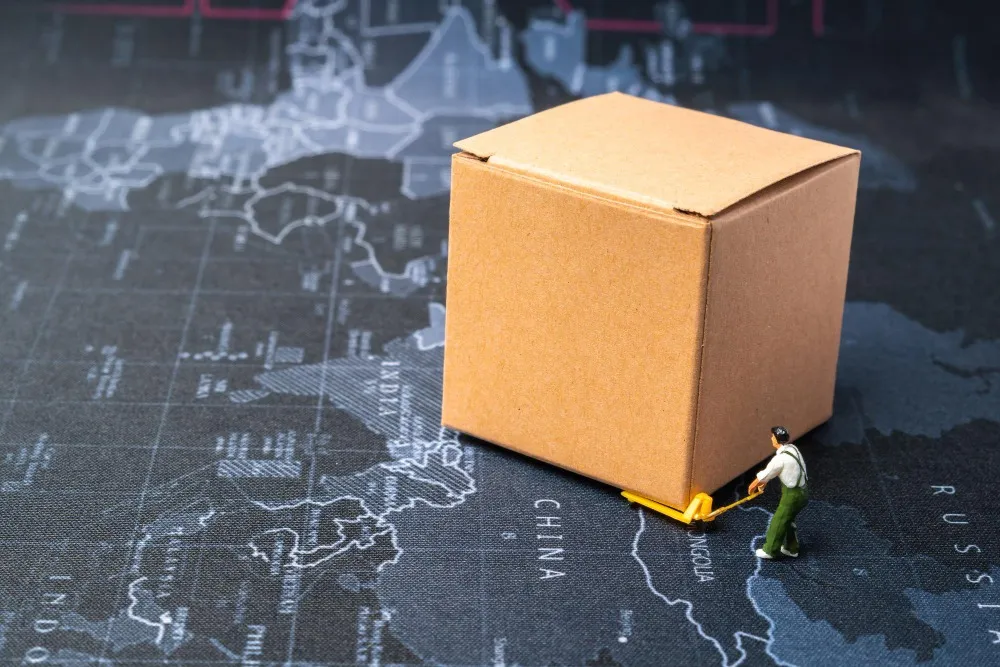Al-Basha Shipping – Best Global Logistics- Supply Chain & International Shipping in Amman Jordan
Al-Basha Shipping – Best Global Logistics- Supply Chain & International Shipping in Amman Jordan
Comprehensive Solutions
We offer a full range of services, including land, air, and sea freight; customs clearance; packing; and storage. With our all-in-one approach, you can rely on us to handle every aspect of your logistics needs, saving you time and effort.
Experienced Team & Advanced Technology
With expertise and a team of skilled professionals, we ensure precision and reliability in every shipment. Our advanced tracking systems keep you informed, providing transparency and peace of mind throughout the process.
Tailored Services & Flexible Options
We understand that every client has unique needs. Whether you require temperature-controlled transport, express delivery, or specialized packaging, our customizable solutions are designed to meet your specific requirements efficiently and carefully.
What we can do for you

+ 00
Experience

+ 00
On-Time Delivery

+ 00
Shipments

+ 00
Countries

Values
- Excellence & Reliability: We are dedicated to delivering unparalleled quality in our services. From shipment handling to customer support, we adhere to the highest standards, ensuring that every process is executed with precision and consistency.
- Customer-Centric Approach: Our clients are at the heart of everything we do. By understanding their unique needs and providing tailored solutions, we foster lasting partnerships built on trust and satisfaction.
- Integrity & Transparency: We operate with honesty, keeping customers informed every step of the way through comprehensive updates and open communication. Trustworthiness is integral to our relationships and commitments.
- Innovation & Adaptability: In a rapidly evolving industry, we continuously seek to embrace new technologies and methodologies to optimize our services and maintain our competitive edge.
- Teamwork & Collaboration: Our team's collective knowledge, expertise, and dedication drive our success. We believe in fostering a supportive environment where collaboration thrives, resulting in exceptional service delivery.
Our vision at AL BASHA TRADING SERVICE is to be recognized as the leading provider of freight solutions, renowned for our efficiency, reliability, and customer-centric approach. We aspire to create a logistics environment where borders are seamlessly traversed and businesses can thrive without restrictions or delays. Through strategic investments in modern technology, infrastructure, and our talented team, we aim to redefine what is possible within the freight and logistics industry.
We envision a future where every shipment we handle contributes to our clients' prosperity, positioning us as a trusted partner that drives global trade and economic development. In doing so, we aim to set new standards of excellence while championing innovative and sustainable freight practices that resonate throughout the industry.
Our mission at AL BASHA TRADING SERVICE is to redefine the freight and logistics landscape by delivering superior, customized, and reliable transport solutions. We aim to be a steadfast partner for our clients, ensuring the secure, timely, and efficient movement of their goods across borders. We seek to foster trust, build lasting relationships, and provide unmatched value by offering seamless shipping experiences through our exceptional expertise and advanced tracking systems.
We strive to maintain operational excellence through continuous improvement, leveraging innovation and extensive industry knowledge. By dedicating ourselves to customer satisfaction, employee empowerment, and the pursuit of sustainable practices, we endeavor to be the first choice for logistics and shipping solutions, paving the way for long-term success and growth for our clients and our company.
What our clients say
Please add description
Read our latest news
- By: admin
- 24 September, 2025
Al Basha Trading – Your Trusted Partner in Land Transport and Integrated Logistics Solutions
For more than 20 years, Al Basha Trading Service has been a leader in the field of land transport and logistics in Jordan. With a strong reputation for reliability, professionalism, and customer-focused service, the company has become a trusted name for clients who require efficient, cost-effective, and secure transport solutions. From land transport between Jordan and the Gulf, Iraq, Lebanon, Syria, and Egypt, to comprehensive customs clearance and logistics services, Al Basha Trading stands out as a one-stop partner for businesses and individuals alike.
1. Land Transport Expertise Across the Region
One of the company’s core strengths is its extensive fleet of trucks, which includes dry trucks, refrigerated units, and frozen cargo carriers. This allows Al Basha Trading to handle all types of shipments—from food and pharmaceuticals requiring temperature control, to industrial goods and large-scale cargo. With professional drivers and advanced tracking systems, clients are assured of timely deliveries and full shipment visibility.
2. Integrated Logistics Solutions
Modern trade requires more than just moving goods from one point to another. Al Basha Trading provides integrated logistics services, including packing, loading, unloading, and customs clearance. The company ensures that shipments meet international standards and regulatory requirements, reducing delays and risks at border crossings. This integrated approach saves clients time and money while ensuring their cargo arrives safely.
3. Customs Clearance Made Simple
Navigating customs procedures can be one of the biggest challenges for businesses engaged in international shipping. With decades of experience, Al Basha Trading’s team of specialists manages the process from start to finish. From documentation to tariff classification, the company simplifies customs clearance and ensures compliance with Jordanian and regional regulations.
4. Serving Key Markets: Gulf, Iraq, Lebanon, Syria, and Egypt
Al Basha Trading specializes in routes that connect Jordan with major regional markets. Whether transporting construction materials to Iraq, food products to Saudi Arabia, or industrial equipment to Egypt, the company’s extensive network and reliable partners guarantee efficiency and competitive pricing. This makes Al Basha Trading an indispensable link in the supply chain for regional trade.
5. Customer-Centric Services
At the heart of Al Basha Trading’s operations is a commitment to customer satisfaction. Clients receive continuous updates and have access to shipment tracking services, ensuring transparency at every stage of the journey. The company also offers flexible payment terms and tailored solutions to meet the specific needs of different industries, from retail and wholesale to manufacturing and distribution.
6. Safety, Reliability, and Accountability
Transporting goods across borders requires strict safety and accountability standards. Al Basha Trading invests in regular maintenance of its fleet, advanced tracking systems, and training for its drivers and staff. This ensures not only the safe handling of goods but also compliance with safety and environmental regulations across all routes.
7. Why Choose Al Basha Trading?
- Over 20 years of experience in Jordan land transport and logistics
- A large fleet of modern trucks (dry, reefer, frozen)
- Professional customs clearance services
- Coverage of all key markets: Gulf, Iraq, Lebanon, Syria, and Egypt
- Customer-first approach with real-time updates and transparent pricing
Conclusion:
As trade in the Middle East continues to grow, businesses need logistics partners they can trust. Al Basha Trading Service combines local expertise, regional connections, and international standards to deliver top-quality transport and logistics solutions. Whether you need land transport to and from Jordan, customs clearance, or integrated supply chain support, Al Basha Trading is your reliable partner for success.
- By: admin
- 06 September, 2025
Freight Shipping Basics
Freight Shipping Basics | A Beginner’s Guide to Understanding Logistics
Introduction
Freight shipping is one of the core elements of supply chains and global trade. If you are starting any kind of business, it’s essential to understand how the shipping and logistics sector works.
In this article, we’ll explore the fundamental concepts of freight shipping, transportation methods, process steps, and the challenges you may face along the way.
What Is Freight Shipping?
Freight shipping is the process of transporting products or raw materials from the point of origin to the desired destination using different transportation methods, including sea, air, land, or rail.
In international trade, shipments may involve multimodal transport, meaning goods are moved using more than one transportation method.
Key Stakeholders in the Shipping Process
- Shipper – The person or company sending the goods.
- Carrier – The company responsible for transporting the goods, such as shipping lines or freight companies.
- Freight Forwarder – A specialized agent coordinating the shipping process between the shipper and carrier. They don’t transport goods themselves but manage logistics and delivery arrangements.
- Customs Broker – An expert in customs regulations who facilitates import and export clearance, ensuring compliance and smooth communication with customs authorities.
- Consignee (Importer) – The person or company receiving the goods at the destination.
Types of Freight Transportation
1. Sea Freight
- Ideal for large, heavy shipments.
- Cost-effective but slower compared to other methods.
- Uses standard shipping containers for efficient cargo handling.
2. Air Freight
- Best for high-value, time-sensitive, or fragile goods.
- More expensive compared to sea and land transport.
- Less suitable for bulky or oversized shipments.
3. Land Freight (Trucking)
- Suitable for domestic shipments or transportation within the same continent.
- Flexible and capable of reaching destinations without direct access to seaports or airports.
4. Rail Freight
- Cost-effective for long-distance shipments within continents.
- Mainly used for transporting heavy goods like metals, minerals, and raw materials.
Steps of the Freight Shipping Process
1. Planning and Preparation
- Identify the type of cargo (hazardous goods, food products, raw materials, etc.).
- Choose the most suitable transportation method based on cargo type, budget, and destination.
2. Preparing Documentation
- Commercial Invoice: Includes shipment details like quantity, price, product description, and seller/buyer info. Used to calculate customs duties.
- Certificate of Origin: Issued by the local chamber of commerce to confirm the country of origin, required for customs compliance and trade agreements.
- Packing List: Contains details about packaging, dimensions, weights, and contents to simplify handling and clearance.
- Bill of Lading: Issued by the carrier confirming receipt of goods and serving as a shipping contract.
3. Packaging and Labeling
- Use proper packaging materials to protect cargo during transit.
- Label shipments with details like fragile, perishable, or hazardous if applicable.
- Ensure packaging complies with customs and carrier requirements.
4. Customs Clearance
- Submit required documents to customs authorities, including export/import declarations, shipping permits, and tax exemption certificates.
- Pay applicable customs duties and taxes.
5. Transportation and Shipping
- Handover cargo to the carrier for delivery.
- Use real-time tracking systems to monitor shipment progress.
- Ensure goods are insured against risks such as damage, theft, or natural disasters.
6. Final Delivery
Once customs clearance and transportation are complete, goods are delivered to the consignee.
Freight Shipping Costs
- Transportation Fees: Depend on the shipping method, cargo type, and distance.
- Insurance Costs: To protect against risks like damage, theft, or natural disasters.
- Customs Duties: For both imports and exports when applicable.
- Packaging and Handling Costs: To ensure safe cargo delivery.
Common Challenges in Freight Shipping
- Shipping Delays – Caused by weather issues, port congestion, or logistical complications.
- Cargo Damage or Loss – Due to poor handling, accidents, or inadequate packaging.
- Customs Complications – Missing documents or delayed clearance.
- High Costs – Especially when using express shipping or handling sensitive goods.
Essential Tips for Beginners in Freight Shipping
- Choose the Right Transport Mode – Based on cargo type, delivery time, and budget.
- Work with Trusted Freight Forwarders – To simplify operations and reduce risks.
- Verify Documentation Accuracy – To avoid clearance delays or penalties.
- Insure Your Cargo – To safeguard against financial loss.
- Use Real-Time Tracking Systems – To stay updated on shipment status and location.
Conclusion
Understanding the basics of freight shipping is the first step to ensuring successful transportation and trade operations. With proper planning, the right partners, and compliance with legal requirements, beginners can manage shipping processes effectively and achieve seamless logistics operations.
References
- By: admin
- 31 August, 2025
The importance of insurance in freight shipping
Cargo Insurance | Importance and Types
Introduction
Cargo shipping is one of the essential activities that facilitate both international and domestic trade. With the growing volume of global commercial transportation, cargo insurance has become a crucial tool to protect financial investments and property during transit.
Cargo insurance provides an effective way to minimize risks that shipments may face during transportation, whether these risks are related to damage, theft, or natural disasters.
In this article, we will discuss the importance of cargo insurance, its types, and how to choose the most suitable coverage.
Why Is Cargo Insurance Important?
The process of shipping goods involves several potential risks that can affect the safety of the cargo while it is being transported from the supplier to the customer. Unexpected incidents may occur, such as fire, collisions, theft, or damage caused by weather conditions like storms and floods.
In such cases, cargo insurance helps companies recover from financial losses resulting from these risks.
By securing cargo insurance, businesses can rest assured that their products will be protected throughout the shipping journey — whether for long-distance or short-distance transportation.
Cargo insurance also helps reduce the potential costs associated with damages or losses, ensuring operational stability and preventing financial surprises that could negatively impact business continuity.
Types of Cargo Insurance
1. All-Risk Insurance
This is the most common and comprehensive type of cargo insurance. It provides full coverage against all potential risks that may affect the goods during transit, including accidents, theft, or damage caused by natural conditions.
However, this policy excludes specific situations that are clearly outlined in the contract.
2. Named Perils Insurance
This type of insurance provides coverage only for specific risks that are agreed upon in advance between the parties, such as fire, collision, or theft.
Any risks not mentioned in the policy are excluded, making this coverage more limited compared to all-risk insurance.
3. Partial Coverage Insurance
This option is used when companies want to insure only part of their cargo or specific types of shipments.
It provides limited coverage and can be an economical choice when the cost of full coverage is high.
4. Marine Insurance
Marine insurance focuses on protecting cargo during sea freight operations.
Since sea shipping is one of the most widely used transportation methods worldwide, this coverage is essential to protect shipments from maritime risks, including sinking, weather-related damages, or cargo loss during transit.
5. Air Freight Insurance
Air transportation is one of the fastest shipping methods but may also involve certain risks, such as delays, cargo damage, or accidents.
Air freight insurance provides coverage for damages or losses that may occur during air cargo transportation.
How to Choose the Right Type of Cargo Insurance
When selecting cargo insurance, companies should carefully evaluate several factors to ensure they receive the most suitable coverage for their needs:
1. Type of Cargo
Insurance requirements vary depending on the nature of the goods being shipped.
For example, fragile or sensitive products like electronics, glass, or food may require specialized insurance for adequate protection.
2. Shipping Method
The choice of insurance depends on whether the shipment is transported by sea, air, or land.
Each method carries different risks, making it important to choose a policy that aligns with the chosen transportation mode.
3. Budget Planning
Insurance costs vary based on the coverage level and shipment size.
Businesses should set a clear budget to choose an insurance type that provides sufficient protection without significantly impacting overall shipping costs.
4. Terms and Conditions
Companies should always read the insurance policy carefully before signing.
Some policies include exclusions or conditions that may affect the level of coverage, so understanding these terms is essential.
Conclusion
Cargo insurance plays a critical role in ensuring the safety and security of goods during transit.
By selecting the right type of insurance and determining the appropriate level of coverage, companies can minimize financial risks caused by potential losses or damages during shipping.
Ultimately, cargo insurance provides businesses with peace of mind, enhances supply chain reliability, and supports business continuity by protecting against unexpected disruptions.















